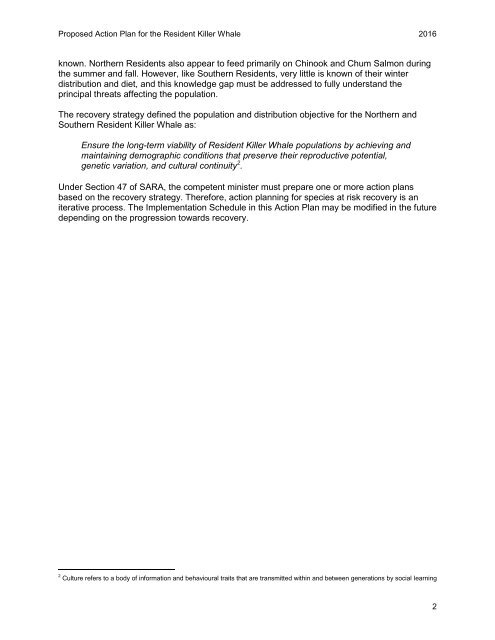Resident Killer Whale
Ap-KillerWhale-v00-2016Jun13-Eng
Ap-KillerWhale-v00-2016Jun13-Eng
You also want an ePaper? Increase the reach of your titles
YUMPU automatically turns print PDFs into web optimized ePapers that Google loves.
Proposed Action Plan for the <strong>Resident</strong> <strong>Killer</strong> <strong>Whale</strong> 2016<br />
known. Northern <strong>Resident</strong>s also appear to feed primarily on Chinook and Chum Salmon during<br />
the summer and fall. However, like Southern <strong>Resident</strong>s, very little is known of their winter<br />
distribution and diet, and this knowledge gap must be addressed to fully understand the<br />
principal threats affecting the population.<br />
The recovery strategy defined the population and distribution objective for the Northern and<br />
Southern <strong>Resident</strong> <strong>Killer</strong> <strong>Whale</strong> as:<br />
Ensure the long-term viability of <strong>Resident</strong> <strong>Killer</strong> <strong>Whale</strong> populations by achieving and<br />
maintaining demographic conditions that preserve their reproductive potential,<br />
genetic variation, and cultural continuity 2 .<br />
Under Section 47 of SARA, the competent minister must prepare one or more action plans<br />
based on the recovery strategy. Therefore, action planning for species at risk recovery is an<br />
iterative process. The Implementation Schedule in this Action Plan may be modified in the future<br />
depending on the progression towards recovery.<br />
2 Culture refers to a body of information and behavioural traits that are transmitted within and between generations by social learning<br />
2


